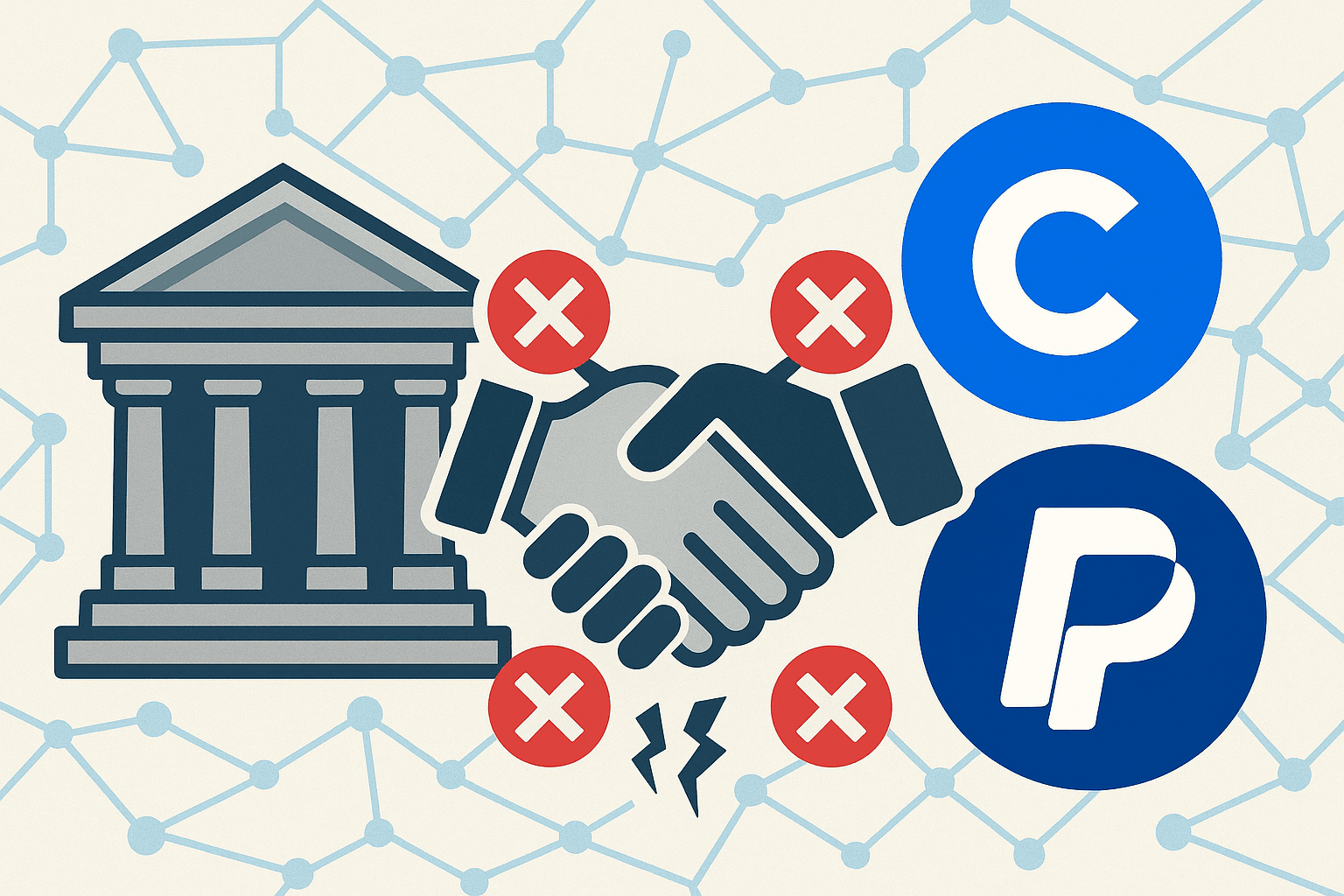The crypto banking revolution has been brewing for years, but as we look at the landscape in 2025, it's clear that the biggest players are making fundamental mistakes. While Coinbase aims to become the "number one financial services app in the world" and PayPal's head of digital currencies emphasizes that "banks need to be part of crypto for stablecoins to succeed," these institutions are missing the real opportunity in programmable money and stablecoin yield infrastructure.
The Status Quo: Crypto as a "Faster Payment Rail"
Coinbase's Custodial Trap: Why Centralized Crypto Banking Fails
Coinbase has built an impressive empire, but it's fundamentally flawed for DeFi business banking. As of 2025, Coinbase is the world's largest Bitcoin custodian, holding over 12% of all bitcoin in existence and positioning stablecoins as "a foundational asset in Coinbase's product ecosystem." Yet their approach treats cryptocurrency like a traditional bank account with blockchain decorations.
The Problem: Users don't actually own their crypto assets. When you buy Bitcoin on Coinbase, "you do not own any specific, identifiable, Crypto Asset" and funds are held in "omnibus accounts." This custodial crypto banking model recreates the exact dependency structure that blockchain technology was designed to eliminate.
The Missed Opportunity: While Coinbase focuses on trading fees and custodial services, they're ignoring the fundamental power of programmable money and high-yield DeFi accounts. Their stablecoin banking strategy centers on USDC revenue sharing rather than unleashing the actual utility of on-chain yield generation.
PayPal's Walled Garden: Crypto Without the Revolution
PayPal crypto banking has made significant strides in cryptocurrency adoption, supporting buying, selling, and holding cryptocurrencies, including Bitcoin, Ethereum, and its own stablecoin, PYUSD. They've even enabled "users to use cryptocurrency for everyday purchases" with automatic conversion at checkout.
The Problem: PayPal's crypto wallet offering is essentially a closed loop. While you can spend crypto through PayPal's merchant network, you can't truly program your money. There's no yield generation, no smart contract integration, no conditional payments just traditional banking with a crypto veneer.
The Regulatory Excuse: PayPal executives hide behind regulatory concerns, but this misses the point entirely. "There's always hesitation: Can I trust this? [The stablecoin legislation] is going to answer a lot of those questions," says MoneyGram's CEO. But waiting for perfect regulatory clarity means missing the DeFi innovation window.
Traditional Banks: Playing Catch-Up with Yesterday's Playbook
The biggest surprise of 2025 might be traditional banks' sudden crypto banking enthusiasm. JPMorgan Chase, Bank of America, Citigroup, Wells Fargo, and other leading American banks are exploring a joint stablecoin initiative, while JPMorgan Chase unveiled JPMD, a blockchain-based deposit token representing institutional U.S. dollar deposits.
The Problem: Banks are applying industrial-age thinking to digital-native technology. JPMorgan's JPMD is essentially a digital version of a traditional deposit, complete with the same limitations. "Unlike today's major stablecoins, deposit tokens could be covered by deposit insurance in the future as well as interest-bearing," but this misses the revolutionary potential of programmable money.
The Innovation Gap: While banks focus on regulatory compliance and deposit insurance, they're ignoring what makes crypto truly transformative: composability, programmability, and instant settlement with yield generation through DeFi protocols.
The Three Fatal Flaws in Current Crypto Banking
1. The Custody Contradiction: Why Self-Custody Matters for Business Banking
Every major crypto banking provider operates on a custodial model that defeats the purpose of blockchain technology. Whether it's Coinbase's omnibus accounts, PayPal's internal ledger, or traditional banks' deposit tokens, users are trading sovereignty for convenience.
The Real Problem: This isn't just about "self-custody" it's about programmability. When institutions control your digital assets, you can't deploy smart contracts, automate yield strategies, or create conditional payment flows. You're stuck with whatever features the provider decides to offer.
Business Impact: A company holding stablecoins in a custodial account cannot implement automated treasury management, pull-based payments, or yield optimization strategies that could significantly improve their bottom line.
2. The Yield Blindness: Missing the $80,000 Annual Opportunity
Perhaps the most glaring oversight in current crypto banking is the complete ignorance of DeFi yield opportunities. While stablecoins have become "an integral asset class of cryptocurrencies" with over $230 billion in market cap, most "crypto banks" let this capital sit completely idle.
The Math: A business holding $1 million in USDC on Coinbase earns exactly $0 in yield. That same $1 million deployed in DeFi lending protocols could generate $60,000-80,000 annually. Multiply this across the entire stablecoin ecosystem, and you're looking at billions in missed opportunities.
Why This Matters: For businesses managing crypto treasury operations, this yield blindness represents a massive opportunity cost. High-yield business bank accounts using DeFi infrastructure can turn idle capital into revenue streams.
3. The Programmability Vacuum: Why Smart Contracts Change Everything
The most fundamental flaw is treating stablecoins like digital fiat rather than programmable money. Current crypto banking providers offer the same services as traditional banks just with blockchain settlement. This completely ignores features that are only possible with smart contracts:
Conditional Payments: Money that releases based on specific triggers
Yield-Powered Subscriptions: Services funded by generated interest
Reversible Transfers: Payments that can be clawed back before settlement
Multi-Signature Treasury: Shared control without trusted intermediaries
Automated Payroll: Pull-based payment: that earn yield until claimed
Dynamic Discounting: Invoice terms that adjust based on yield generation
Business Applications: Companies using programmable money infrastructure can implement crypto cash management strategies impossible with traditional banking services, including automated treasury workflows and yield-based business models.
Market Gaps: The $2 Trillion Opportunity
The crypto banking market is projected to explode, with Standard Chartered projecting that the stablecoin market could grow to $2 trillion by the end of 2028. But current providers are positioned to capture only a fraction of this value because they're competing on the wrong vectors.
Gap #1: Business Treasury Management Revolution
Financial institutions offering digital asset custody services might start to create opportunities in areas like blockchain development, digital currency offerings, cyber-security, marketing, and customer support. But they're missing the core need: businesses want their cash management to work harder.
The Problem: Small and medium businesses are sitting on stablecoin treasuries earning zero yield while paying 2-3% transaction fees to traditional payment processors. There's a massive arbitrage opportunity for platforms that can eliminate fees while generating passive income through DeFi yield.
The Solution: High-yield crypto business accounts that automatically deploy funds into DeFi lending protocols while maintaining instant liquidity for operations. This transforms payment processing from a cost center into a revenue stream.
Gap #2: Cross-Border Payment Innovation Beyond Speed
Stablecoins "can enable quicker and more affordable international payments, and can be used to bring financial services to the over 1 billion people worldwide who lack access to traditional banking." But current solutions are just faster versions of correspondent banking.
The Real Innovation: Programmable escrows, conditional releases, and yield generation during settlement periods. A contractor payment that earns yield until the work is completed, or an invoice that offers dynamic discounting based on early payment—these are impossible with current crypto banking providers.
Business Case: Companies handling cross-border payments could save thousands in fees while earning yield on funds in transit, creating a positive-sum financial workflow that benefits both payers and recipients.
Gap #3: Consumer Banking Evolution
PayPal and Coinbase treat consumers like tourists in the crypto ecosystem buy some Bitcoin, maybe spend it occasionally, but don't expect sophisticated financial tools. This ignores the massive opportunity in programmable consumer banking:
Yield-bearing checking accounts that automatically optimize across DeFi protocols
Smart subscriptions that pull from interest-generating balances
Shared accounts with programmable spending controls and yield distribution
The RebelFi Alternative: Programmable Money Infrastructure
While major players focus on regulatory arbitrage and custody fees, RebelFi is building what crypto banking should actually look like: programmable financial infrastructure that makes every dollar work harder through DeFi integration and smart contract automation.
Instant Yield Architecture: Beyond Traditional Banking
Instead of custodial accounts that earn nothing, RebelFi deploys every deposit into DeFi lending protocols in the same transaction. Businesses don't just store money, they generate passive income from day one through automated yield optimization.
Technical Innovation: Every stablecoin deposit immediately flows into high-yield DeFi protocols while maintaining instant liquidity for business operations. This instant yield model transforms idle capital into revenue-generating assets without operational complexity.
Business Impact: Companies can earn 6-8% APY on operational capital while maintaining full spending flexibility, turning treasury management into a profit center rather than a cost center.
Pull-Based Payment Innovation: Smart Money Movement
Rather than push payments that create operational risk, RebelFi's secure transfer system lets payers authorize payments that recipients claim when ready. The sender continues earning yield until the moment of transfer, and payments can be revoked if the recipient loses access.
How It Works:
Authorize payment with recipient wallet verification
Funds continue earning yield in DeFi protocols until claimed
Recipient pulls payment when ready with on-chain verification
Automatic yield calculation and distribution
Business Benefits: This pull-based payment model reduces payment errors, enables yield generation during payment processing, and provides chargeback-like functionality for B2B transactions.
Zero-Fee Business Model: Revenue from Yield, Not Fees
While traditional processors charge 2-3% transaction fees, RebelFi generates revenue from yield sharing. This turns payment processing from a cost center into a profit center for merchants through DeFi yield strategies.
The Economics: Instead of paying processing fees, businesses earn money on every transaction through automated yield generation. RebelFi captures value from the DeFi yield rather than merchant fees, creating a positive-sum business model.
Competitive Advantage: This zero-fee payment processing model is only possible with programmable money infrastructure and DeFi integration - impossible for custodial crypto banking providers to replicate.
True Non-Custodial Operations: Smart Account Architecture
Unlike Coinbase's omnibus accounts or PayPal's internal ledgers, RebelFi users control their own smart accounts on Solana blockchain. This enables full programmability while maintaining user sovereignty and regulatory compliance.Smart Account Features:
Multi-signature controls for business treasury management
Automated yield routing across DeFi protocols
Programmable spending limits and approval workflows
Real-time yield tracking and financial reporting
Integration APIs for existing business systems
Why This Matters: Non-custodial architecture enables programmable financial workflows that custodial providers cannot offer, including conditional payments, automated treasury strategies, and custom business logic.
The Corporate Stablecoin Wave: Validation of the Programmable Money Thesis
The biggest validation of programmable money comes from an unexpected source: corporate stablecoin issuance. Amazon and Walmart are reportedly exploring issuing their own stablecoins, with both retailers spending an estimated $14 billion annually on card processing fees.
This isn't just about saving on interchange fees it's about creating programmable payment flows that are impossible with traditional rails. When Walmart issues WalCoin, they'll want:
Automatic supplier payments based on inventory triggers
Loyalty programs funded by stablecoin yield generation
Conditional escrows for supply chain financing
Multi-signature treasury management across corporate divisions
Current crypto banking providers can't deliver these features because they're built on custodial, non-programmable architectures.
The Regulatory Red Herring: Innovation vs. Compliance
Most crypto banking providers use regulatory uncertainty as an excuse for limited innovation. But the regulatory landscape is rapidly clarifying. The FDIC has clarified that "FDIC-supervised institutions may engage in permissible crypto-related activities without receiving prior FDIC approval", and the GENIUS Act recently passed the Senate, establishing "a legal framework for issuing stablecoins in the US."
Why Regulation Isn't the Real Barrier
The real barrier isn't regulation, it's imagination. Companies like Coinbase and PayPal have the resources to build programmable money infrastructure, but they're trapped by traditional banking mental models.Current Regulatory Environment:
FDIC guidance allows banks to engage in crypto activities
GENIUS Act provides stablecoin regulatory framework
Corporate stablecoins getting regulatory approval
DeFi protocols operating within compliance frameworks
Innovation Opportunity: The regulatory clarity actually enables more sophisticated crypto banking services, not fewer. Programmable money platforms can operate within compliance frameworks while delivering DeFi-powered banking that custodial providers cannot match.
Looking Forward: The 2025 Inflection Point
As we move through 2025, the crypto banking landscape is approaching an inflection point. "We will see financial institutions trying to play catch up as more coins and tokens come to market and banks try to find a way to monetize these efforts," according to fintech investor Adrian Mendoza.
The Coming Consolidation
But catching up isn't enough. The companies that will dominate the next decade are those building programmable money infrastructure today, not digital versions of 20th-century banking.
Market Predictions:
Corporate stablecoins will drive demand for programmable infrastructure
Traditional banks will partner with DeFi platforms rather than build in-house
Custodial crypto banking will lose market share to programmable alternatives
Yield generation will become standard expectation for business banking
The Bottom Line: Coinbase, PayPal, and traditional banks are competing to be the best at moving money faster. The real opportunity is in making money smarter through programmable financial infrastructure.
Conclusion: The Future of Crypto Banking
While they optimize for custody and compliance, the future belongs to platforms that unleash the full potential of programmable financial infrastructure through DeFi integration, smart contracts, and automated yield strategies.
The $2 Trillion Opportunity: The stablecoin market isn't just about digital dollars, it's about programmable money that can automatically generate yield, execute conditional logic, and create entirely new financial workflows for both businesses and consumers.
What This Means for Businesses: Companies that adopt programmable money infrastructure early will have significant advantages in treasury management, payment processing costs, and operational efficiency. The question isn't whether crypto banking will evolve, it's whether your business will be part of the programmable money revolution or stuck with digital versions of traditional banking.The companies that understand this distinction will build the financial infrastructure of the future. The rest will remain glorified digital banks, optimizing yesterday's solutions for tomorrow's opportunities.
Ready to Experience Programmable Money? RebelFi's platform enables instant yield generation, smart payment flows, and truly non-custodial crypto banking for businesses ready to make their capital work harder. Discover how DeFi business banking can transform your treasury management and payment processing into revenue streams.
Frequently Asked Questions
Q: What is programmable money?
A: Programmable money refers to digital currency (like stablecoins) that can execute smart contract logic, enabling features like automated yield generation, conditional payments, and programmable financial workflows impossible with traditional banking.
Q: How does DeFi yield generation work for businesses?
A: DeFi yield generation automatically deploys business stablecoin balances into decentralized lending protocols that earn 6-8% APY while maintaining instant liquidity for operations. This turns idle capital into revenue streams without operational complexity.
Q: Is non-custodial crypto banking secure for businesses?
A: Non-custodial crypto banking using smart accounts provides greater security than custodial solutions because businesses maintain control of their private keys while benefiting from programmable features and DeFi integration. Multi-signature controls enable enterprise-grade security with shared governance.
Q: How do pull-based payments benefit B2B transactions?
A: Pull-based payments allow payers to authorize payments that recipients claim when ready, reducing payment errors while enabling yield generation until the moment of transfer. This provides chargeback-like functionality for B2B transactions while maintaining DeFi yield optimization.



